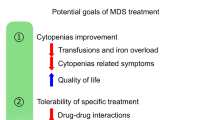Abstract
Recent studies have reported that the absolute lymphocyte count (ALC) during induction therapy is predictive of treatment outcome in de novo acute lymphoblastic leukemia (ALL); however, the significance of ALC on outcomes remains controversial. In the present study, we assessed the significance of ALC at day 29 (ALC-29), the end of induction therapy, on outcomes in our Japanese cohort. The outcomes of 141 patients aged ≤18 years with newly diagnosed ALL who were enrolled on the JACLS ALL-02 at our hospitals were analyzed in terms of ALC-29. Patients with ALC-29 ≥750/μL (n = 81) had a superior 5-year EFS (95.2 ± 2.7 vs 84.3 ± 4.8 %, P = 0.016) and OS (100 vs 87.0 ± 4.7 %, P = 0.0062). A multivariate analysis identified ALC-29 ≥750/μL as a significant predictor of improved EFS and OS after controlling for confounding factors. A multiple linear regression model revealed a significant inverse relationship between the percentage of blasts in bone marrow on day 15 and ALC-29 (P = 0.005). These results indicate that ALC is a simple prognostic factor in childhood ALL, and, thus, has the potential to refine current risk algorithms.




Similar content being viewed by others
References
Pui CH, Relling MV, Downing JR. Acute lymphoblastic leukemia. N Engl J Med. 2004;350(15):1535–48.
Schultz KR, Pullen DJ, Sather HN, Shuster JJ, Devidas M, Borowitz MJ, et al. Risk- and response-based classification of childhood B-precursor acute lymphoblastic leukemia: a combined analysis of prognostic markers from the Pediatric Oncology Group (POG) and Children’s Cancer Group (CCG). Blood. 2007;109(3):926–35.
Moricke A, Reiter A, Zimmermann M, Gadner H, Stanulla M, Dordelmann M, et al. Risk-adjusted therapy of acute lymphoblastic leukemia can decrease treatment burden and improve survival: treatment results of 2169 unselected pediatric and adolescent patients enrolled in the trial ALL-BFM 95. Blood. 2008;111(9):4477–89.
Patel B, Rai L, Buck G, Richards SM, Mortuza Y, Mitchell W, et al. Minimal residual disease is a significant predictor of treatment failure in non T-lineage adult acute lymphoblastic leukaemia: final results of the international trial UKALL XII/ECOG2993. Br J Haematol. 2010;148(1):80–9.
Stow P, Key L, Chen X, Pan Q, Neale GA, Coustan-Smith E, et al. Clinical significance of low levels of minimal residual disease at the end of remission induction therapy in childhood acute lymphoblastic leukemia. Blood. 2010;115(23):4657–63.
Alkayed K, Halalsheh H, Khattab E, Abualruz AR, Ibrahim A, Madanat F. Lack of prognostic significance of absolute lymphocyte count after intensive induction therapy in childhood acute lymphoblastic leukemia. Pediatr Blood Cancer. 2012;59(2):351.
De Angulo G, Yuen C, Palla SL, Anderson PM, Zweidler-McKay PA. Absolute lymphocyte count is a novel prognostic indicator in ALL and AML: implications for risk stratification and future studies. Cancer. 2008;112(2):407–15.
Rabin KR, Gramatges MM, Borowitz MJ, Palla SL, Shi X, Margolin JF, et al. Absolute lymphocyte counts refine minimal residual disease-based risk stratification in childhood acute lymphoblastic leukemia. Pediatr Blood Cancer. 2012;59(3):468–74.
Rubnitz JE, Campbell P, Zhou Y, Sandlund JT, Jeha S, Ribeiro RC, et al. Prognostic impact of absolute lymphocyte counts at the end of remission induction in childhood acute lymphoblastic leukemia. Cancer. 2013;119(11):2061–6.
Sun D, Elson P, Liedtke M, Medeiros BC, Earl M, Alizadeh A, et al. Absolute lymphocyte count at day 28 independently predicts event-free and overall survival in adults with newly diagnosed acute lymphoblastic leukemia. Am J Hematol. 2012;87(10):957–60.
Hasegawa D, Hara J, Suenobu S, Takahashi Y, Sato A, Suzuki N, et al. Successful abolition of prophylactic cranial irradiation in children with non-T acute lymphoblastic leukemia in the Japan Association of Childhood Leukemia Study (JACLS) ALL-02 trial. Blood (ASH Annual Meeting Abstracts). 2011;118:653.
Asai D, Imamura T, Suenobu S, Saito A, Hasegawa D, Deguchi T, et al. IKZF1 deletion is associated with a poor outcome in pediatric B-cell precursor acute lymphoblastic leukemia in Japan. Cancer Med. 2013;2:412–9.
Kaplan EL, Meier P. Nonparametric-estimation from incomplete observations. J Am Stat Assoc. 1958;53(282):457–81.
Peto R, Pike MC, Armitage P, Breslow NE, Cox DR, Howard SV, et al. Design and analysis of randomized clinical-trials requiring prolonged observation of each patient. 2. Analysis and examples. Br J Cancer. 1977;35(1):1–39.
Cox DR. Regression models and life-tables. J Roy Stat Soc B. 1972;34(2):248–75.
Shen HQ, Feng JH, Tang YM, Song H, Yang SL, Shi SW, et al. Absolute lymphocyte count is associated with minimal residual disease level in childhood B-cell precursor acute lymphoblastic leukemia. Leuk Res. 2013;37(6):671–4.
Chang YJ, Zhao XY, Huo MR, Xu LP, Liu DH, Liu KY, et al. Clinical impact of absolute lymphocyte count on day 30 after unmanipulated haploidentical blood and marrow transplantation for pediatric patients with hematological malignancies. Am J Hematol. 2011;86(2):227–30.
Ishaqi MK, Afzal S, Dupuis A, Doyle J, Gassas A. Early lymphocyte recovery post-allogeneic hematopoietic stem cell transplantation is associated with significant graft-versus-leukemia effect without increase in graft-versus-host disease in pediatric acute lymphoblastic leukemia. Bone Marrow Transplant. 2008;41(3):245–52.
Porrata LF, Litzow MR, Tefferi A, Letendre L, Kumar S, et al. Early lymphocyte recovery is a predictive factor for prolonged survival after autologous hematopoietic stem cell transplantation for acute myelogenous leukemia. Leukemia. 2002;16:1311–8.
Acknowledgments
The authors thank Mrs. Hiroko Wada for her special assistance in this study.
Author information
Authors and Affiliations
Corresponding author
Ethics declarations
Conflict of interest
The authors declare no conflict of interest.
About this article
Cite this article
Hirase, S., Hasegawa, D., Takahashi, H. et al. Absolute lymphocyte count at the end of induction therapy is a prognostic factor in childhood acute lymphoblastic leukemia. Int J Hematol 102, 594–601 (2015). https://doi.org/10.1007/s12185-015-1875-0
Received:
Revised:
Accepted:
Published:
Issue Date:
DOI: https://doi.org/10.1007/s12185-015-1875-0




